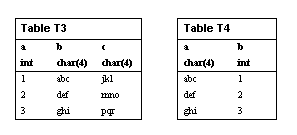When you use union statements:
All select lists in the union statement must have the same number of expressions (such as column names, arithmetic expressions, and aggregate functions). The following statement is invalid because the first select list is longer than the second:
create table stores_east (stor_id char(4) not null, stor_name varchar(40) null, stor_address varchar(40) null, city varchar(20) null, state char(2) null, country varchar(12) null, postalcode char(10) null, payterms varchar(12) null)
select stor_id, city, state from stores union select stor_id, city from stores_east
drop table stores_east
Corresponding columns in all tables, or any subset of columns used in the individual queries, must be of the same datatype, or an implicit data conversion must be possible between the two datatypes, or an explicit conversion should be supplied. For example, a union is not possible between a column of the char datatype and one of the int datatype, unless an explicit conversion is supplied. However, a union is possible between a column of the money datatype and one of the int datatype. See union and “Datatype Conversion Functions” in the Reference Manual for more information about comparing datatypes in a union statement.
You must place corresponding columns in the individual queries of a union statement in the same order, because union compares the columns one to one in the order given in the query. For example, suppose you have the following tables:
Figure 3-2: Union comparing columns

This query:
select a, b from T3 union select b, a from T4
produces:
a b
--------- ---
1 abc
2 def
3 ghi
(3 rows affected)
The following query results in an error message, because the datatypes of corresponding columns are not compatible:
select a, b from T3 union select a, b from T4
drop table T3
drop table T4
When you combine different (but compatible) datatypes such as float and int in a union statement, Adaptive Server converts them to the datatype with the most precision.
Adaptive Server takes the column names in the table resulting from a union from the first individual query in the union statement. Therefore, to define a new column heading for the result set, do so in the first query. In addition, to refer to a column in the result set by a new name, for example, in an order by statement, refer to it in that way in the first select statement.
The following query is correct:
select Cities = city from stores union select city from authors order by Cities